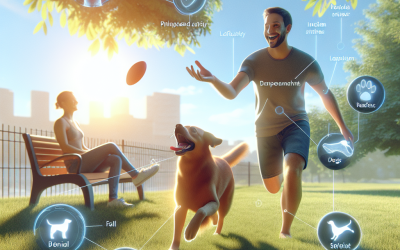How to Train Your Dog to Be Your Running Partner
Introduction
Are you an avid runner looking for a furry companion to join you on your daily jogs? If so, training your dog to be your running partner is not only a fantastic way to bond with your pet but also a great way to enhance both your fitness levels. How to Train Your Dog to Be Your Running Partner is a topic that has garnered increasing attention in recent years, reflecting a growing trend towards active lifestyles that include our pets.
With more pet owners prioritizing fitness, many are discovering the joys of running alongside their dogs. This trend is supported by various studies suggesting that exercising with pets can lead to healthier habits for both humans and animals. In fact, a recent survey indicated that dog owners are more likely to meet their fitness goals when they incorporate their pets into their routines.
In this article, we will explore the essential aspects of training your dog for running, including the right techniques, benefits, and potential challenges. By the end, you’ll have a clear understanding of how to get started and what you need to consider to ensure a successful running partnership with your canine friend.
Before we dive deeper, it’s crucial to recognize the importance of proper dog training techniques for optimal results. For insights on effective dog training methods, check out this comprehensive guide.
What is How to Train Your Dog to Be Your Running Partner?
Definition
Training your dog to be your running partner involves teaching your pet to jog alongside you in a safe and controlled manner. This process includes building your dog’s stamina, ensuring they can handle the distance and pace of your runs, and reinforcing commands that will help keep them safe during your outings.
Historical Context
The concept of exercising with dogs is not new. Historically, dogs have been companions for hunters and shepherds, accompanying their owners on long treks. However, the formal training of dogs for running has evolved significantly over the years. Today, it’s recognized that different breeds have varying levels of endurance and energy, which can influence their suitability as running partners.
In the 21st century, as pet ownership has surged, more people are seeking ways to integrate their dogs into their active lifestyles. This shift has led to an increase in resources available for dog owners, including specialized training programs and community running clubs that welcome dogs.
The Importance of How to Train Your Dog to Be Your Running Partner
Training your dog to run with you is more than just an enjoyable activity; it’s an opportunity to enhance your dog’s physical health and mental well-being. Regular running can help reduce obesity in dogs, improve cardiovascular health, and provide essential mental stimulation.
Moreover, the bond you strengthen through this shared activity can lead to increased loyalty and a deeper understanding between you and your dog. This is particularly significant as more pet owners seek ways to engage with their pets beyond traditional walks.
Dog Fitness in the Context of the Pet Care Industry
As the pet care industry continues to grow, there is an increasing emphasis on animal fitness. This includes not only physical activities like running but also proper nutrition and wellness. Understanding dog fitness is essential for ensuring that your pet can safely participate in running activities. For tips on maintaining your pet’s health through diet, check out these useful guidelines on gut health for pets.
Key Players or Contributors
Several organizations and fitness experts have emerged as leaders in promoting dog fitness, offering workshops and resources tailored to dog owners. Noteworthy are dedicated trainers who specialize in running with dogs, providing valuable insights into how to train effectively.

How Does How to Train Your Dog to Be Your Running Partner Work?
Assessing Your Dog’s Readiness
Before you start training your dog to run with you, it’s crucial to evaluate whether they are physically ready. Here are some key considerations:
- Age: Puppies should not run long distances until they are at least 12 months old, as their bones and joints are still developing.
- Breed: Some breeds are naturally better suited for running than others. Breeds like Labrador Retrievers, Vizslas, and Border Collies tend to thrive in running environments.
- Health: Always consult your veterinarian to ensure your dog is in good health and capable of handling the exercise.
Gradual Training Process
Once you’ve assessed your dog’s readiness, it’s time to begin the training process. Here’s a step-by-step guide to training your dog to be your running partner:
- Start with Short Walks: Begin with short walks to get your dog used to being active alongside you. Gradually increase the distance over time.
- Introduce Running: Once your dog is comfortable walking with you, start to incorporate short bursts of running. Use commands like “let’s go” to signal the start of running.
- Use Positive Reinforcement: Reward your dog with treats and praise for good behavior during your runs. This encourages them to associate running with positive experiences.
- Gradually Increase Distance and Speed: Slowly increase the distance and pace of your runs as your dog builds stamina. Keep an eye on their energy levels and adjust accordingly.
- Monitor Their Condition: Be vigilant for signs of fatigue or distress. If your dog seems tired, take a break or shorten your runs.
Essential Gear for Running with Your Dog
Having the right equipment can significantly enhance your running experience. Here are some essentials to consider:
- Leash: A hands-free leash can allow for better control while you run. Look for leashes that are adjustable and comfortable for both you and your dog.
- Harness: A well-fitted harness is safer and more comfortable for your dog than a collar, especially during vigorous activity.
- Hydration: Ensure you have water for both you and your dog during your runs, especially on warmer days. Portable water bottles and bowls are excellent options.
Safety Tips for Running with Your Dog
Safety should always come first when running with your dog. Here are some tips to keep in mind:
- Watch the Weather: Avoid running in extreme heat or cold, as it can be harmful to your dog.
- Choose Safe Routes: Opt for safe, dog-friendly trails or parks where your dog can enjoy the run without distractions or hazards.
- Know When to Stop: Be aware of your dog’s limits and be ready to stop if they show signs of exhaustion or discomfort.
Benefits of Training Your Dog to Be Your Running Partner
Physical Benefits
Training your dog to run alongside you offers numerous physical benefits for both of you:
- Improved Health: Regular running can lead to better cardiovascular health, weight management, and overall fitness.
- Increased Endurance: Over time, both you and your dog will build endurance, allowing for longer and more enjoyable runs.
Mental and Emotional Benefits
The benefits extend beyond physical health. Running with your dog can also enhance mental and emotional well-being:
- Bonding Experience: Shared activities strengthen the bond between you and your dog, enhancing trust and companionship.
- Stress Relief: Exercise is a known stress reliever. Running with your dog allows both of you to enjoy the outdoors while alleviating stress.
Social Interaction
Running with your dog also provides opportunities for social interaction:
- Meet Other Dog Owners: Running in parks or joining running groups can lead to meeting other dog owners, fostering a sense of community.
- Participate in Events: Many cities host dog-friendly running events, allowing you to enjoy competition and camaraderie.
Overcoming Challenges in Training Your Dog to Be Your Running Partner
Common Challenges
Despite the numerous benefits, there can be challenges in training your dog for running:
- Distractions: Dogs can be easily distracted by other animals, people, or smells. Training them to focus on you is essential.
- Behavioral Issues: Some dogs may exhibit leash pulling or aggressive behavior towards other dogs. Addressing these issues early on with proper training is crucial.
Solutions to Challenges
To overcome these challenges, consider the following strategies:
- Consistent Training: Regular training sessions will reinforce good behavior and help your dog learn to stay focused.
- Socialization: Exposing your dog to different environments and other dogs can help reduce distractions and improve behavior.
- Professional Help: If you encounter significant challenges, consider seeking help from a professional dog trainer who specializes in running with dogs.
Future Trends in Dog Running Training
The Rise of Canine Fitness Programs
As the trend of including pets in fitness routines grows, we can expect to see more canine fitness programs and resources becoming available. These programs will likely focus on:
- Customized Training Plans: Tailored training plans that cater to the specific needs of different breeds and fitness levels.
- Community Support: Increased community-based running clubs that encourage dog owners to participate together, fostering a sense of belonging.
Advancements in Technology
Technology is also playing a role in the future of dog running training:
- Fitness Trackers: More pet fitness trackers will be developed, allowing owners to monitor their dog’s health and performance during runs.
- Mobile Apps: Applications designed for dog owners can provide workout plans, track mileage, and connect with other dog runners in the area.
Conclusion
Training your dog to be your running partner is a rewarding and enriching experience that benefits
Resource Links:
- akc.org: Start by adding small stretches of running into your walks. Then, on each subsequent walk, gradually increase the portion of your time spent running and …
- reddit.com: … Lots of tips and tricks there from some pretty experienced runners. The main thing is to teach the dog that running is their job (especially …
- whatthepup.spotandtango.com: Be patient with your dog as they learn how to run with you. Olive has turned out to not only be a super fun running buddy but an intelligent training partner, …




0 Comments